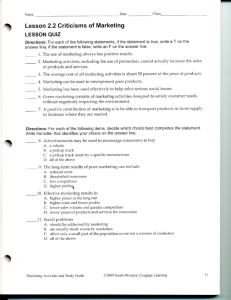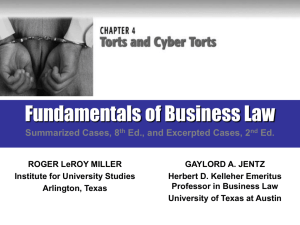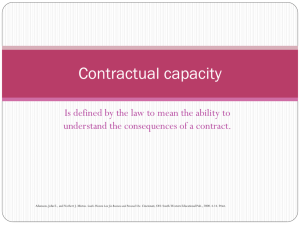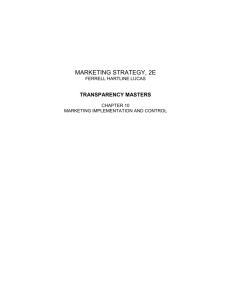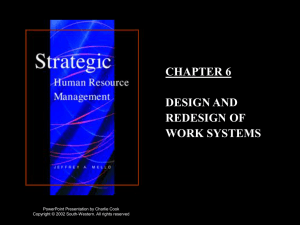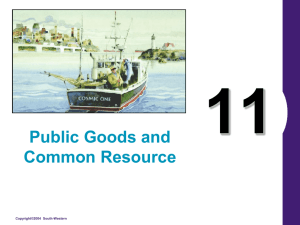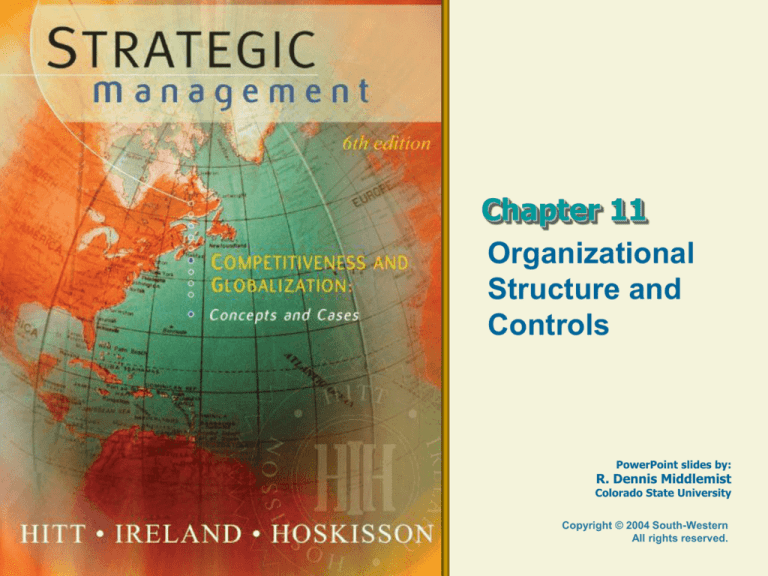
Chapter 11
Organizational
Structure and
Controls
PowerPoint slides by:
R. Dennis Middlemist
Colorado State University
Copyright © 2004 South-Western
All rights reserved.
Knowledge Objectives
• Studying this chapter should provide you with the
strategic management knowledge needed to:
Define organizational structure and controls and discuss
the difference between strategic and financial controls.
Describe the relationship between strategy and structure.
Discuss the functional structures used to implement
business-level strategies.
Explain the use of three versions of the multidivisional (Mform) structure to implement different diversification
strategies.
Discuss the organizational structures used to implement
three international strategies.
Define strategic networks and strategic center firms.
Copyright © 2004 South-Western. All rights reserved.
11–2
The Strategic
Management
Process
Figure 1.1
Copyright © 2004 South-Western. All rights reserved.
Copyright © 2004 South-Western. All rights reserved.
11–3
Organizational Structure
• Organizational structure specifies:
The firm’s formal reporting relationships,
procedures, controls, and authority and decisionmaking processes
The work to be done and how to do it, given the
firm’s strategy or strategies
• It is critical to match organizational
structure to the firm’s strategy
Copyright © 2004 South-Western. All rights reserved.
11–4
Organizational Structure
• Effective structures provide:
Stability
Flexibility
• Structural stability provides:
The capacity required to consistently and
predictably manage daily work routines
• Structural flexibility provides for:
The opportunity to explore competitive
possibilities
The allocation of resources to activities that
shape needed competitive advantages
Copyright © 2004 South-Western. All rights reserved.
11–5
Organizational Controls
• Purposes of Organizational Controls:
Guide the use of strategy
Indicate how to compare actual results with
expected results
Suggest corrective actions to take when the
difference between actual and expected results is
unacceptable
• Two types of organizational controls
Strategic controls
Financial controls
Copyright © 2004 South-Western. All rights reserved.
11–6
Organizational Controls
Strategic
Controls
Organizational
Controls
• Subjective Criteria
Are concerned with examining the fit between:
What the firm might do (opportunities in its external
environment
What the firm can do (competitive advantages)
Evaluate the degree to which the firm focuses on
the requirements to implement its strategy
Copyright © 2004 South-Western. All rights reserved.
11–7
Organizational Controls
Strategic
Controls
Organizational
Controls
Financial
Controls
• Objective criteria
Accounting-based measures include:
Return on investment
Return on assets
Market-based measures include:
Economic Value Added (EVA)
Copyright © 2004 South-Western. All rights reserved.
11–8
Matching Control to Strategy
• Relative use of controls varies by type of
strategy
Large diversified firms using a cost leadership
strategy emphasize financial controls
Companies and business units using a
differentiation strategy emphasize strategic
controls
Copyright © 2004 South-Western. All rights reserved.
11–9
Relationships between Strategy and
Structure
• Strategy and structure have a reciprocal
relationship:
Structure flows from or follows the selection of
the firm’s strategy
but …
Once in place, structure can influence current
strategic actions as well as choices about future
strategies
Copyright © 2004 South-Western. All rights reserved.
11–10
Evolutionary Patterns of Strategy and
Organizational Structure
• Firms grow in predictable patterns:
First by volume
Then by geography
Then integration (vertical, horizontal)
And finally through product/business
diversification
• A firm’s growth patterns determine its
structural form
Copyright © 2004 South-Western. All rights reserved.
11–11
Evolutionary Patterns of Strategy and
Organizational Structure
• All organizations require some form of
organizational structure to implement and
manage their strategies
• Firms frequently alter their structure as they
grow in size and complexity
• Three basic structure types:
Simple structure
Functional structure
Multidivisional structure (M-form)
Copyright © 2004 South-Western. All rights reserved.
11–12
Strategy and Structure
Growth Pattern
Efficient implementation
of formulated strategy
• As firms grow larger and
become more complex,
structural challenges
emerge
• Firms’ larger sizes dictate
the need for more
sophisticated workflows and
integrating mechanisms
Simple
Functional
Efficient implementation
of formulated strategy
Multidivisional
Figure 11.1
Copyright © 2004 South-Western. All rights reserved.
11–13
Strategy and Structure: Simple Structure
• Owner-manager
Makes all major decisions directly
Monitors all activities
• Staff
Serves as an extension of the manager’s
supervisor authority
• Matched with focus strategies and businesslevel strategies
Commonly compete by offering a single product
line in a single geographic market
Copyright © 2004 South-Western. All rights reserved.
11–14
Simple Structure (cont’d)
• Growth creates:
Complexity
Managerial and structural challenges
• Owner-managers
Commonly lack organizational skills and
experience
Become ineffective in managing the specialized
and complex tasks involved with multiple
organizational functions
Copyright © 2004 South-Western. All rights reserved.
11–15
Strategy and Structure: Functional Structure
• Chief Executive Officer (CEO)
Limited corporate staff
• Functional line managers in dominant
organizational areas of:
Manufacturing Marketing
Accounting
R&D
resources
Engineering
Human
• Supports use of business-level strategies
and some corporate-level strategies
Single or dominant business with low levels of
diversification
Copyright © 2004 South-Western. All rights reserved.
11–16
Functional Structure (cont’d)
• Differences in orientation among
organizational functions can:
Impede communication and coordination
Increase the need for CEO to integrate decisions
and actions of business functions
Facilitate career paths and professional
development in specialized functional areas
Cause functional-area managers to focus on
local versus overall company strategic issues
Copyright © 2004 South-Western. All rights reserved.
11–17
Strategy and Structure: Multidivisional
Structure
• Strategic Control
Operating divisions function as separate
businesses or profit centers
• Top corporate officer delegates
responsibilities to division managers
For day-to-day operations
For business-unit strategy
• Appropriate as firm grows through
diversification
Copyright © 2004 South-Western. All rights reserved.
11–18
Multidivisional Structure (cont’d)
• Three Major Benefits
Corporate officers are able to more accurately
monitor the performance of each business,
which simplifies the problem of control
Facilitates comparisons between divisions,
which improves the resource allocation process
Stimulates managers of poorly performing
divisions to look for ways of improving
performance
Copyright © 2004 South-Western. All rights reserved.
11–19
Matching Strategy and Functional Structure
• Different forms of the functional
organizational structure are matched to:
Cost leadership strategy
Differentiation strategy
Integrated cost leadership/differentiation strategy
• Differences in these forms are seen in three
important structural characteristics:
Specialization (number and types of jobs)
Centralization (decision-making authority)
Formalization (formal rules and work procedures)
Copyright © 2004 South-Western. All rights reserved.
11–20
Functional Structure for Cost Leadership Strategy
Notes: • Operations is the main function
• Process engineering is emphasized rather than new product R&D
• Relatively large centralized staff coordinates functions
• Formalized procedures allow for emergence of a low-cost culture
• Overall structure is mechanical; job roles are highly structured
Copyright © 2004 South-Western. All rights reserved.
Figure 11.2
11–21
Functional Structure under
a Cost Leadership Strategy
• Operations is the main function
Process engineering is emphasized over
research and development
Large centralized staff oversees activities
Formalized procedures guide actions
Structure is mechanical
Job roles are highly structured
Copyright © 2004 South-Western. All rights reserved.
11–22
Functional Structure for Implementation of
a Differentiation Strategy
Notes:• Marketing is the main function for keeping track of new product ideas
• New product R&D is emphasized
• Most functions are decentralized, but R&D and marketing may have centralized staffs that work closely with each other
• Formalization is limited so that new product ideas can emerge easily and change is more readily accomplished
• Overall structure is organic; job roles are less structured
Figure
Copyright © 2004 South-Western. All rights reserved.
11.3
11–23
Functional Structure under
a Differentiation Strategy
• Marketing is the main function for tracking
new product ideas
New product R&D is emphasized
Most functions are decentralized
Formalization is limited to foster change and
promote new ideas
Overall structure is organic
Job roles are less structured
Copyright © 2004 South-Western. All rights reserved.
11–24
Implementing an Integrated Cost
Leadership/ Differentiation Strategy
• Selling products that create customer value
due to:
Their relatively low product cost through an
emphasis on manufacturing and process
engineering, with infrequent product changes
Reasonable sources of differentiation based on
new-product R&D are emphasized while
manufacturing and process engineering are not
• Used frequently in global economy
Copyright © 2004 South-Western. All rights reserved.
11–25
Implementing an Integrated Cost
Leadership/Differentiation Strategy (cont’d)
• The integrated form of the functional
structure must have:
Decision-making patterns that are partially
centralized and partially decentralized
Semi-specialized jobs
Rules and procedures that allow both formal and
informal job behaviors
Copyright © 2004 South-Western. All rights reserved.
11–26
Corporate-Level Strategies and the
Multidivisional Structure
• A firm’s continuing success that leads to:
Product diversification, or
Market diversification, or
Both product and market diversification
• Increasing diversification creates control
problems that the functional structure can’t
handle
Information processing, coordination
Control
Copyright © 2004 South-Western. All rights reserved.
11–27
Corporate-Level Strategies and the
Multidivisional Structure (cont’d)
• Diversification strategy requires firm to
change from functional structure to a
multidivisional structure
• Different levels of diversification create the
need for implementation of a unique form of
the multidivisional structure
Copyright © 2004 South-Western. All rights reserved.
11–28
Variations of the Multidivisional Structure
Figure 11.4
Copyright © 2004 South-Western. All rights reserved.
11–29
Cooperative Form of Multidivisional Structure: Related-Constrained Strategy
Notes • Structural integration devices create tight links among all divisions
• Corporate office emphasizes centralized strategic planning, human
resources, and marketing to foster cooperation between divisions
• R&D is likely to be centralized•
Copyright © 2004 South-Western. All rights reserved.
• Rewards are subjective and tend to emphasize overall corporate
performance in addition to divisional performance
• Culture emphasizes cooperative sharing
Figure 11.5
11–30
Multidivisional Structure: Cooperative Form
• Horizontal integration is used to bring about
interdivisional cooperation
• Sharing divisional competencies facilitates
development of economies of scope
• To foster divisional cooperation, the
corporate office emphasizes centralization:
Strategic planning
Human resources
Marketing
Related-Constrained Strategy
Copyright © 2004 South-Western. All rights reserved.
11–31
Cooperative Form (cont’d)
• R&D is likely to be centralized
• Frequent, direct contact between division
managers encourages and supports
cooperation and sharing of competencies
and resources
• Use of liaison roles
• Rewards are subjective, emphasizing overall
corporate performance in addition to
divisional performance
Related-Constrained Strategy
Copyright © 2004 South-Western. All rights reserved.
11–32
SBU Form of Multidivisional Structure: Related-Linked Strategy
Notes: • Structural integration among divisions within SBUs, but independence
across SBUs
• Strategic planning may be the most prominent function in headquarters
for managing the strategic planning approval process of SBUs for the
president
Copyright © 2004 South-Western. All rights reserved.
• Each SBU may have its own budget for staff to foster integration
• Corporate headquarters staff serve as consultants to SBUs and divisions,
rather than having direct input to product strategy, as in the cooperative form
Figure 11.6
11–33
Multidivisional Structure: SBU Form
• Strategic business unit (SBU) form is a
structure consisting of three levels:
Corporate headquarters
Strategic business units (SBUs)
SBU divisions
• Divisions within SBUs share
Products, or markets, or both
Related-Linked Strategy
Copyright © 2004 South-Western. All rights reserved.
11–34
Multidivisional Structure: SBU Form
• Divisions within SBUs develop economies of
scope and/or scale by sharing product or
market competencies
Each SBU is a profit center controlled and
evaluated by the headquarters office
• Used by large firms
Can be complex due to an organization’s size
and diversity in products and markets
Related-Linked Strategy
Copyright © 2004 South-Western. All rights reserved.
11–35
Competitive Form of Multidivisional Structure:
Unrelated Strategy
Notes • Corporate headquarters has a small staff
• Finance and auditing are the most prominent functions
in the headquarters office to manage cash flow and
assure the accuracy of performance data coming from
divisions
• The legal affairs function becomes important when the firm acquires or
divests assets
• Divisions are independent and separate for financial evaluation purposes
• Divisions retain strategic control, but cash is managed by the corporate office
• Divisions compete for corporate resources
Figure 11.7
Copyright © 2004 South-Western. All rights reserved.
11–36
Multidivisional Structure: Competitive Form
• A structure in which there is complete
independence among the firm’s divisions
Divisions do not share common corporate
strengths
Because strengths aren’t shared, integrating
devices aren’t developed
Organizational arrangements emphasize
divisional competition rather than cooperation
Unrelated Strategy
Copyright © 2004 South-Western. All rights reserved.
11–37
Competitive Form (cont’d)
• Three benefits from the internal competition
Flexibility—corporate headquarters can have
divisions working on different technologies to
identify those with greatest future potential
Challenges the status quo and inertia
Motivates effort
• Creates specific profit performance
expectations for each division to promote
internal competition for resources
Unrelated Strategy
Copyright © 2004 South-Western. All rights reserved.
11–38
Characteristics of Structures to Implement
Diversification Strategies (cont’d)
a Strategy
implemented with structural form.
Copyright © 2004 South-Western. All rights reserved.
Table 11.1
11–39
International Strategies and Worldwide
Structures
• Allow the firm to search for new:
Markets
Resources
Core competencies
Technologies
Copyright © 2004 South-Western. All rights reserved.
11–40
Worldwide Geographic Area Structure:
Multidomestic Strategy
Notes: • The perimeter circles indicate decentralization of
operations
• Emphasis is on differentiation by local demand to fit
an area or country culture
• Corporate headquarters coordinates financial
resources among independent subsidiaries
• The organization is like a decentralized federation
Copyright © 2004 South-Western. All rights reserved.
Figure 11.8
11–41
Worldwide Geographic Area Structure:
Implementing a Multidomestic Strategy
• Multidomestic strategy decentralizes
strategic and operating decisions to:
Business units in each country
Product characteristics tailored to local
preferences
• Firms counter global competitive forces by:
Establishing protected market positions, or
Competing in industry segments most affected
by differences among local countries
Copyright © 2004 South-Western. All rights reserved.
11–42
Worldwide Geographic Area Structure
• Worldwide geographic area structure
Emphasizes national interests
Facilitates the firm’s efforts to satisfy local or
cultural differences
• Multidomestic strategy
Requires little coordination between different
county markets: integrating mechanisms aren’t
needed
Key disadvantage is inability to create global
efficiencies
Copyright © 2004 South-Western. All rights reserved.
11–43
Worldwide Product Divisional Structure:
Global Strategy
Notes • The headquarters’ circle indicates centralization to
coordinate information flow among worldwide products
• Corporate headquarters uses many intercoordination
devices to facilitate global economies of scale and scope
• Corporate headquarters also allocates financial resources
in a cooperative way
• The organization is like a centralized federation
Copyright © 2004 South-Western. All rights reserved.
Figure 11.9
11–44
Worldwide Product Divisional Structure:
Implementing a Global Strategy
• Global strategy
Allows firm to offer standardized products
across country market
• Effects on Firm
Success depends on firm’s ability to develop and
take advantage of economies of scope and scale
on global level
Firm tends to outsource some primary or support
activities to the world’s best providers
Copyright © 2004 South-Western. All rights reserved.
11–45
Worldwide Product Divisional Structure
• Centralizes decision-making authority in the
worldwide division headquarters
Headquarters coordinates and integrates
decisions and actions among divisional business
units
• Integrating mechanisms are important:
Direct contact between managers
Liaison roles between departments
Temporary task forces as well as permanent
teams
Copyright © 2004 South-Western. All rights reserved.
11–46
Combination Structure: A Transnational
Strategy
• Transnational Strategy
Combines multidomestic strategy’s local
responsiveness with global strategy’s efficiency
• Combination structure draws characteristics
and mechanisms from both:
Worldwide geographic area structure
Worldwide product divisional structure
• Appropriate integrating mechanisms for the
combination structure are less obvious
Copyright © 2004 South-Western. All rights reserved.
11–47
Cooperative Strategies and Network
Structures
• Network strategy exists when:
Partners form several alliances in order to
improve performance of the alliance network
itself through cooperative endeavors
• Strategic Network
A group of firms formed to create value by
participating in multiple cooperative
arrangements such as alliances and joint
ventures
Copyright © 2004 South-Western. All rights reserved.
11–48
Cooperative Strategies and Network
Structures (cont’d)
• Strategic networks are used to implement:
Business-level strategies
Corporate-level strategies
International cooperative strategies
• Strategic center firm
The firm around which the network’s cooperative
relationships revolve
Copyright © 2004 South-Western. All rights reserved.
11–49
A Strategic Network
Strategic
Center
Firm
Adapted from
Figure 11.10
Copyright © 2004 South-Western. All rights reserved.
11–50
Strategic Center Firm
• Is the foundation for the strategic network’s
structure
Concerned with aspects of organizational
structure such as formal reporting relationships.
Manages the complex, cooperative interactions
among network partners
• Engages in four primary tasks:
Strategic outsourcing
Technology
Copyright © 2004 South-Western. All rights reserved.
Competencies
Race to learn
11–51
Implementing Business-Level Cooperative
Strategies
• Vertical complementary alliances
Firms have complementary competencies in
different value chain stages that let them
cooperatively integrate their different skills
• Horizontal complementary alliances
Firms agree to combine competencies in order to
create value in the same stage of the value chain
Copyright © 2004 South-Western. All rights reserved.
11–52
Implementing Business-Level Cooperative
Strategies (cont’d)
• The strategic center firm is obvious in
vertical complementary strategic alliances,
but not always in horizontal complementary
strategic alliances
Copyright © 2004 South-Western. All rights reserved.
11–53
Implementing Business-Level Cooperative
Strategies: International Franchising
• Franchising
A common form of cooperative strategy used to
facilitate product and market diversification
Allows the firm to use its competencies to extend
or diversify its product or market reach without
completing a merger or acquisition
Copyright © 2004 South-Western. All rights reserved.
11–54
Implementing Corporate-Level Cooperative
Strategies: International
• Strategic networks
Are used to implement international cooperative
strategies for competing in several countries
Differences in countries’ regulatory environments
increase the challenge of managing international
networks
• Distributed strategic networks
Are the organizational structure used to manage
international cooperative strategies
Regional strategic center firms
Copyright © 2004 South-Western. All rights reserved.
11–55
A Distributed Strategic Network
Main
Strategic
Strategic
Center
Center
Firm
Firm
= Distributed Strategic Center Firms
Copyright © 2004 South-Western. All rights reserved.
Adapted from
Figure 11.11
11–56


